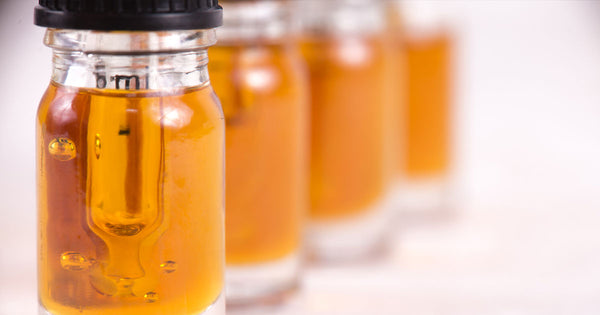Creating Cannabis Distillate: How Everything But the Cannabinoid Is Removed
Jun 10, 2022

Cannabis distillates are the foundation for many of the industry’s most popular products. Gummies, soft gels, lotions, disposable vapes. Distillate is the active ingredient that infuses these products with THC, CBD, or any other cannabinoid.
Why is distillate so unique? The distillation process removes everything but the high-potency cannabinoids to create a pure ingredient for edibles, topicals, capsules, and vapes. Consistency in cannabis extracts is vital in creating a reliable and pure product.
How do cannabis processors make cannabis distillate? Does the production process differ from other extraction techniques? Our distillate production guide breaks down each step of the process and its necessary equipment.
What Is Cannabis Distillate?

Cannabis distillate is usually an odorless, tasteless, and colorless cannabis oil that contains up to 90-95 percent THC or CBD. High-potency THC distillate or CBD distillate are popular products in medical and recreational markets. Medical patients may require higher potencies for fast-acting and long-term relief. High-tolerance recreational users may prefer the high-potency of distillates.
Since the distillation process refines and purifies the cannabis oil to contain a single to a few cannabinoids, there are many types of distillates available, including THC distillate, CBD distillate, CBN distillate, and distillates of other minor cannabinoids.
Cannabis distillate differs in consistency, appearance, and chemical composition from other cannabis concentrates. Cannabis distillate usually only contains a single to a handful of cannabinoids. Other cannabis concentrate types, like live resin, contain other cannabis plant compounds like terpenes.
For users looking for a high cannabinoid concentration, cannabis distillates are a good choice. During the cannabis distillation process, the product’s aroma and flavor are removed. However, terpenes can be reintroduced into cannabis products like vape cartridges for enhanced flavor and aroma.
How Is Cannabis Distillate Made?

All cannabis concentrates start as biomass (harvested plant material). Biomass can range in quality, from low-quality trim to high-quality flower buds. The final quality of the oil will depend on the biomass quality, extraction method, and purification process.
Here is how cannabis distillates are made in a lab-grade setting.
Cannabis Extraction
Making cannabis distillate starts with the crude oil extraction of the biomass. During this initial step of the process, solvent-based or mechanical extraction techniques are used to separate the cannabis plant material from its resinous trichome glands.
Cannabis trichomes produce the plant’s active ingredients, including cannabinoids, terpenes, and flavonoids. Growers harvest the plant at its peak freshness for higher potency and better aroma and flavor. Trichomes are mainly found on the plant’s flowers but are also found in lower concentrations on the sugar leaves, stems, and trim.
For large-scale production, cannabis extractions are generally solvent-based and use hydrocarbons (butane and propane), ethanol, or carbon dioxide (CO2) in its supercritical state as the primary solvent. Solventless methods like rosin pressing may also be used to create a high-quality THC distillate, but is less efficient.
Whether the extraction process is butane hash oil (BHO) extraction or rosin pressing, the starting cannabinoid extract will contain unwanted compounds such as terpenes, fats, waxes, and lipids. These undesirable compounds must be removed to create the final product.
In a closed-loop system, the solvent tank holds the solvent. When the extraction process begins, the solvent is washed over the cannabis plant matter in the material tank. As the solvent washes over the plant material, the solvent easily separates the cannabis oils.
Once the solvent separates the trichomes from the plant matter, the crude cannabis oil is pushed through to the collection tank. An active solvent recovery method is used to remove the residual solvent from the crude oil back into the solvent tank for reuse.
Winterization
After the primary extraction process is complete, the next step is winterization. The winterization process uses cold temperatures to remove undesirable compounds like waxes, fats, and chlorophyll from the crude oil.
During winterization, extraction technicians add ethanol to the crude oil and store the solution at sub-zero temperatures for about 24 hours or up to 48 hours. Maintaining the crude oil at low temperatures for this long ensures the impurities separate from the extracted oil and rise to the top of the mixture.
When the waxes and lipids have coagulated from the rest of the mixture, also referred to as the miscella, extraction technicians use a filter press to filter the fats from the cannabis extract.
Decarboxylation
Following the winterization process, the decarboxylation process is necessary to activate the acidic cannabinoids in the mixture. Without this step, the compounds remain inactive and do not produce the desired therapeutic and psychoactive effects.
In a vacuum atmosphere, decarboxylation converts the acidic forms (THCA and CBDA) into their parent and active compounds (THC and CBD). The process preferably occurs under a vacuum to preserve desired compounds. THCA decarboxylates very slowly into THC, even at room temp. For processing, however, it is usually done at around 220º F.
Under vacuum, heat is applied to the extracted oil, residual solvent, and terpenes from the mixture. When THCA/CBDA turns to THC/CBD during the decarboxylation process, CO2 is produced. Proper decarboxylation of the crude extract ensures that residual CO2 is removed from the oil. CO2 in the mixture can affect the vacuum depths during the distillation process.
Distillation
At this point, the extracted oil should be free from fats, waxes, and residual solvents. The desired cannabinoids such as THC and CBD can now be distilled.
During this process, the oil is heated under a vacuum to reduce boiling temperatures. When the heat reaches a specific boiling temperature, the compound turns to vapor, separates from the solution, and is re-condensed back into a liquid as it passes through a chilled condensing head.
Using various temperatures throughout the process and then re-cooling the vapor ensures the technicians can separate fractions of the oil, piece by piece. Technicians collect the heads, tails, and main body of the miscella. The main body refers to the portion that has the purified distillate.
Processors may perform multiple passes to further purify the oil. A highly distilled cannabis extract may appear almost completely clear compared to darker distillate oils.
End Products: Vapes, Edibles, Topicals, and More

Cannabis distillate oil can be used for a wide range of end products. After the distillation process, the oil can go through the post-processing stages, depending on the type of desired cannabis product: edibles, vape cartridges, tinctures, topicals.
Each cannabis derivative product has a unique production method, requiring different post-processing steps such as crystallization or chromatography.
Cannabis Distillation Equipment
Making cannabis distillate requires various types of equipment. However, the type of distillation equipment used depends on the type of extraction method used. Here is a quick breakdown of the type of equipment that is needed to make cannabis distillates:
- Primary extraction equipment (closed-loop hydrocarbon, ethanol, or CO2 extractor)
- Winterization equipment
- Decarboxylation equipment
- Filtration press
- Distillation equipment (wiped film distillation, short path distillation, etc.)
Wiped-Film vs. Short Path Distillation Process
Short path distillation and wiped-film distillation are the two most popular types of distillation equipment used in this process. Short-path is reserved for smaller yields while, wiped-path is used for higher and more continuous throughput.
Short-Path Distillation
Short-path distillation involves heating a flask containing the crude oil. The heat allows the cannabinoids and terpenes to vaporize. The vapor moves through a condensing head, where it is turned back into a liquid for collection.
Wiped-Film Distillation
Wiped-film distillation, also known as thin-film distillation, is standard in larger-scale facilities that require continuous distillate production. A single wiped-film distillation unit can replace over one dozen short-path distillation units.
Similar to a short path, wiped film evaporation involves heating the crude oil to a specific temperature. When heated to the right temperature, the desired cannabinoids are vaporized and condensed back into liquids in a separate collection chamber.
During this process, the extracted oil falls down a heated wall in the equipment. Rotating wipers continuously spread the oil over the evaporative surface in a thin film. When the wall reaches a specific temperature, the desired cannabinoid evaporates and is re-condensed.
Media Bros: Color Remediation At Its Finest
Media Bros’ selection of premium filter media for hydrocarbon, CO2, and ethanol extraction delivers unparalleled and safe oil filtration. Remove stubborn colors and unwanted compounds from the plant material with innovative filter media and hardware. Request a filter sample today!






